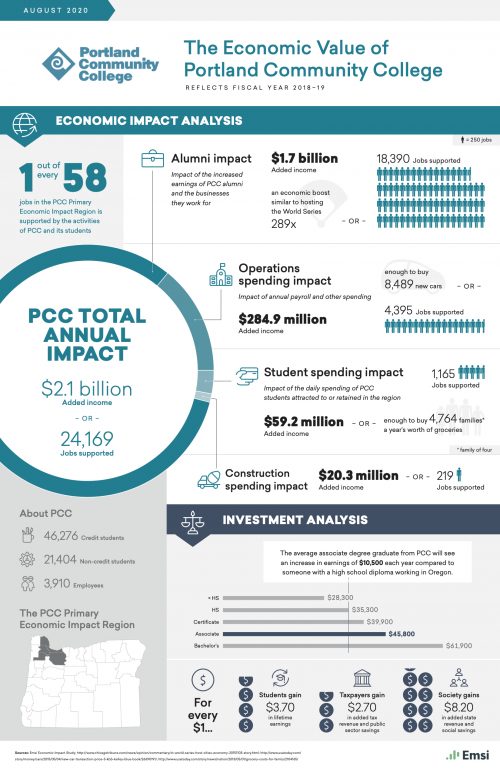This content was published: February 11, 2021. Phone numbers, email addresses, and other information may have changed.
Emsi study finds PCC added billions of dollars to local and regional economy
Photos and Story by James Hill
An economic impact study found that Portland Community College creates billions of dollars in value for the state’s economy and plays a key role in helping students increase their employability and achieve their goals.
The report – based on 2018-19 data – found that PCC added $2.1 billion in income, or supported 24,169 jobs, to the region’s economy. This contribution, which is a value approximately equal to 1.4% of the region’s total gross regional product, was over half of the entire arts, entertainment, and recreation industry in the region (Clackamas, Columbia, Multnomah, Washington and Yamhill counties).
In addition, the report found for every dollar of public money invested in PCC, taxpayers will receive $2.70 in return, over the course of students’ working lives. The average annual rate of return for taxpayers is 9.2%.
The economic impact report came from Emsi, which is a labor market analytics firm that provides economic impact studies and labor market data to educational institutions in the U.S. and internationally.
Emsi’s economic impact study reported, “PCC provides students with the education, training, and skills they need to have fulfilling and prosperous careers, as well as a place to meet new people, increase their self-confidence, and promote their overall health and well-being. It serves regional businesses, and benefits society as a whole in Oregon from an expanded economy and improved quality of life. The benefits created by PCC even extend to the state and local government through increased tax revenues and public sector savings.”
Key Highlights
- The net impact of the college’s operations spending added $284.9 million in income to the regional economy.
- Impact of PCC’s construction spending was $20.3 million in added income for the region.
- The expenditures of relocated and retained students added $59.2 million in income to economy.
- Impact of PCC’s former students currently employed in the regional workforce amounted to $1.7 billion in added income.
- Students will receive $1.1 billion in increased earnings over their working lives. This translates to a return of $3.70 in higher future earnings for every dollar students invest in their education. Students’ average annual rate of return is 17.1%.
- For every dollar invested in PCC in 2018-19, people in Oregon will receive $8.20 in return, for as long as these students remain active in the state workforce.
The Results
The analysis concluded that PCC is a strong investment for all three major stakeholder groups—students, taxpayers and society.
The report added, “Students receive a great return for their investments in a PCC education. At the same time, taxpayers’ investment in PCC returns more to government budgets than it costs and creates a wide range of social benefits throughout Oregon. The results of this study demonstrate that PCC creates value from multiple perspectives. The college benefits regional businesses by increasing consumer spending in the region and supplying a steady flow of qualified, trained workers to the workforce. PCC enriches the lives of students by raising their lifetime earnings and helping them achieve their individual potential. The college benefits state and local taxpayers through increased tax receipts and a reduced demand for government-supported social services.
“Finally, PCC benefits society as a whole in Oregon by creating a more prosperous economy and generating a variety of savings through the improved lifestyles of students,” it stated.

